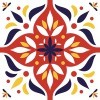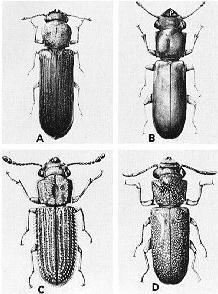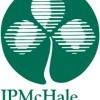How to Get Rid of Beetle Larvae in House
I hope somebody can help me. I'm getting little flea/beetle looking bugs that a tiny what looks like a shell (like a beetle) and wings. I've never seen them fly. Most of them seen to be around my hall and kitchen windows, on the draining board and on the units (not in cupboards yet). They also seem to be on the ceilings, plus some around the light in the living room.
I do have a cat and a dog so I know there not fleas (animal). Could anyone please help me? I don't know what they are or how to kill/treat them. Help me please.

July 28, 2009 0 found this helpful
These could be powderpost beetles feeding on the dry inner walls (studs) of your home. Better check it out. Here is more info : Pictures on bottom of page. Barry
Non Subterranean Termites And Other Wood Destroying Insects
Drywood Termites Termites In Furniture Dampwood Termites Powderpost Beetles Carpenter Ants
Drywood Termites
Unlike the Subterranean termite, they do not require any contact with the soil. They live in un decayed wood with a low moisture content.
DESCRIPTION:
Individuals are in distinct forms or castes - reproductives, workers, and soldiers. Each performs a separate biological function. Only the reproductives are winged (4 wings).
Their are no workers in the drywood termite group - instead the young reproductives and soldiers serve as workers until they mature. The vast majority in the colony is the worker caste and the workers and the reproductives have chewing mouthparts especially adapted for chewing wood. It is the workers who do the wide-spread destruction. The soldiers have powerful mandibles to attack their enemies (usually ants).
Male and Female reproductives up to 1/2 inch long.
Bodies soft and cylindrical in shape, usually pale brown in color; six legged; they have compound eyes and chewing type mouthparts. During the winged stage there are 4 equal size wings that extend longer than the body by 1/8-1/4 inch.
Soldier 3/8 inch;
DIET:
Wood and occasionally other cellulose materials. They eat wood in houses, utility poles, furniture and dying trees. They can not digest the cellulose directly. They have other microorganisms (protozoans and bacteria) in their stomachs that help break down the cellulose which then can be digested by their own metabolism.
HABITAT:
They live in small social colonies in dry wood. They mate and fly to new dry wood areas; enter a small hole in the wood and start to form a colony.In the first year, colony size may be only around 50 . After 4 years, there may be as many as 700 individuals in one colony. At this time, the colony may swarm to start the cycle over again. After 15 years, the colony will have grown to approximately 3,000 individuals. They do not need a source of water and live off of the water that is produced from the digestion of the cellulose.
They infest dry, un decayed wood, including structural lumber as well as dead limbs of native trees and shade and orchard trees, utility poles, posts, and lumber in storage.
The Drywood variety have a low moisture requirement and can tolerate dry conditions for prolonged periods. They remain entirely above ground and do not connect their nests to the soil.
Piles of their fecal pellets, which are distinctive in appearance, may be a clue to their presence.
From these areas, winged reproductives seasonally migrate to nearby buildings and other structures usually on sunny days during fall months.
This type is usually found in the humid coastal and subtropical regions (i.e. California, Hawaii, Florida, Arizona, South and North Carolina, New Mexico, Texas, Alabama, Mississippi, Louisiana and Puerto Rico). They usually infest attic spaces or exterior wood members exposed to them when they swarm in early spring or summer.
Click on map for a larger picture
Typical signs of infestation include:
1. Shed wings
2. Ejected pellets
3. Galleries inside wood are typical signs of a drywood termite infestation.
4. Swarming ants are many times confused with termites, but their differences are easy to recognize. At: Differences between ants and termites ,you will find a list and chart showing you the difference.
5. Piles of their fecal pellets, which are distinctive in appearance, may be a clue to their presence.
The fecal pellets of drywood and dampwood termites
Picture from: © 1996 The Regents of the University of California
Fecal pellets of drywood and dampwood termites. are elongate (about 0.03 inch long) with rounded ends and have six flattened or roundly depressed surfaces separated by six longitudinal ridges.
RECOMMENDATIONS FOR TREATMENT IN DRYWOOD TERMITES:
Treatment for drywood termites consists of:
1.Structural fumigation. This is done by a certified pest control operator. The entire building is covered tightly with a fumigation cover and a sulfuryl fluoride(Vikane) or methyl bromide gas is fumigated.
2.Direct Wood Treatment(Spot treatments) To prepare for use of a a liquid, aerosol, or dust formulation, holes are drilled into the infested timbers through the termite galleries, using a 1/2 " drill in larger timbers and smaller drills elsewhere. Insecticide is then forced through these holes to be dispersed through the galleries. DRIONE DUST is labeled for such use. Dusts should be injected in the galleries in small amounts.
Too much dust would clog the galleries, and the termites will wall off and isolate these areas.
When treating limited infestations, aerosols like INVADER and Drione dust may be used. If you inject a water-based insecticide in a wooden beam..it may produce a favorable site for decay fungi. From: UC Pest Management Guidelines-Drywood Termites, you will find information on detection, whole structure vs. spot treatments, eliminating existing infestations, whole structure treatments and long term preventive treatments.
Another very good site to consult about the drywood variety and the options you have can be found at : Drywood options at University of Florida
--------------------------------------------------------------------------------
RETURN TO TOP
DRYWOOD AND OTHER NON SUBTERRANEAN TERMITES IN FURNITURE:
Because of their ability to live in wood without soil contact, non subterranean like the drywood termite, powder post beetles, or dampwood termites,are frequently carried in infested furniture and other wooden objects into geographical areas where they are not normally found.
As the name implies, the drywood variety establish in dry, sound wood that may have as little as 3 percent moisture content. They are not dependent upon a constant moisture supply as are the subterranean type.
One of the common symptoms of drywood attack is the accumulation of tiny, straw-colored fecal pellets inside or beneath infested furniture. These pellets sift from small holes in the surface of infested wood or are pushed out through small round openings maintained by the termites for this purpose. The hard fecal pellets have six distinct, concave surfaces. Presence of pellets does not prove damaged wood is currently infested, as pellets continue to sift from furniture for many years after termites are controlled or die. However, large, consistent accumulations of pellets are a convincing sign the termites are still active.
If the furniture is untreated, use TIMBOR or BORACARE.
Spray and allow it to penetrate the wood.
It will last the life of the wood and kill the active beetles.
If the wood is painted or varnished, you will need to strip the finish to use either one of these products.
Drywood Termites and Powder post beetles can be killed by either extreme heating or freezing. It would need 1.5 hours in a heated chamber of 150 degrees F or4 hours in a chamber of 140 degrees F. You can also use freezing temperatures to kill these insects.
Exposure at 156 degrees F for four days will kill them. You will need to take care that either extreme of temperature would not damage the article.
--------------------------------------------------------------------------------
RETURN TO TOP
DAMPWOOD TERMITES
Winged dampwood termites
They don't require contact with the soil in order to obtain moisture, but wood with a high degree of moisture is needed. They are usually associated with wood decay. Because of their high moisture requirements, they most often are found in cool, humid areas along the coast.
Pacific dampwood termites (at times called a "rotten wood termite") is a major pest at low altitudes along the coastal areas of California, Washington and Oregon.
Winged reproductives are dark brown with brown wings. Soldiers have a flattened brown or yellowish brown head with elongated black or dark brown mandibles. Nymphs are cream-colored with a characteristic spotted abdominal pattern caused by food in their intestines.
Dampwood termites nest in wood buried in the ground.
In nature, they are commonly found in tree stumps and fallen tree branches. In your home the most likely areas to find them would be an older wood deck, leaky roof eaves, leaky showers or tubs, or substructures with inadequate ventilation or plumbing leaks.
The Dampwood termite is much larger than the drywood and subterranean, measuring in at 3/8 to 3/4 of an inch. They can swarm periodically throughout the year and it is common to see the swarming reproductives caught in spider webs next to exterior lights since they are instinctively attracted to light.
The work of the colony is done by the immature soldiers or reproductives, there is no worker caste.
Swarms are small.
They produce a fecal pellet similar to the drywood termite's, but it is slightly larger and has a more irregular shape. Damage in wood can be identified by a velvety appearance in the galleries.
They produce distinctive fecal pellets that are rounded at both ends, elongate, but lacking clear longitudinal ridges common to drywood termite pellets; flattened sides are noticeable.
,
The Nevada dampwood termites are slightly smaller and darker than the Pacific species; reproductives are about 3/4 inch long.
The Nevada dampwood termite occurs in the higher, drier mountainous areas of the Sierras where it is an occasional pest in mountain cabins and other forest structures; it also occurs along the northern California coast. It differs from the Pacific dampwood in being subterranean in "habit". It attacks only moist wood. This termite is of horticultural importance because it frequently attacks the underground parts os shrubs an young trees. It occurs often in citrus groves.It is also found in fence posts, baseboards and door frames of buildings. Flights occur in July and August in evenings after rains.
The Florida dampwood termite is found in the extreme southeastern counties of Florida and in the keys. It lives naturally in damp( but solid) logs near salt water, and is common pest of buildings in this limited area. It is not subterranean by nature, although it may enter logs beneath the soil.
Control of Dampwood Termites:
Chemical treatment may be not necessary for the control of dampwood termites. Since the dampwood termite requires wood with a high moisture content, correction of the moisture source is necessary. This normally means replacing the existing infested and saturated wood in conjunction with elimination of the moisture source.
Common correction methods:
Increase the ventilation in the affected area, reducing the moisture and repair leaky showers and plumbing.
Make sure you have proper drainage.
Construction needs to be designed to avoid contact of wood and soil.
If the damp wood is not accessible to be removed, treatment of the soil with an effective insecticide or termite baiting systems would be necessary.
--------------------------------------------------------------------------------
RETURN TO TOP
POWDER POST BEETLES
Picture courtesy : UC Riverside Entomology
In this section we will discuss four types of Powderpost beetles in four families: Lyctidae, Bostrichidae, Anobiidae, and Cerambycidae. Adults do little damage, it is the larvae that does the major part of the damage.They go through a complete metamorphosis: adults, eggs, larvae and pupae.


August 4, 2009 0 found this helpful
Beetles can enter your home many ways. One of the most common ways they can enter your home is though a window that is not screened. A lot of these pests are attracted to light, and will easily enter your home that way.
Screening windows in is part of integrated pest management (IPM).
How to Get Rid of Beetle Larvae in House
Source: https://www.thriftyfun.com/Getting-Rid-of-Beetles-in-Your-House.html
0 Response to "How to Get Rid of Beetle Larvae in House"
Post a Comment